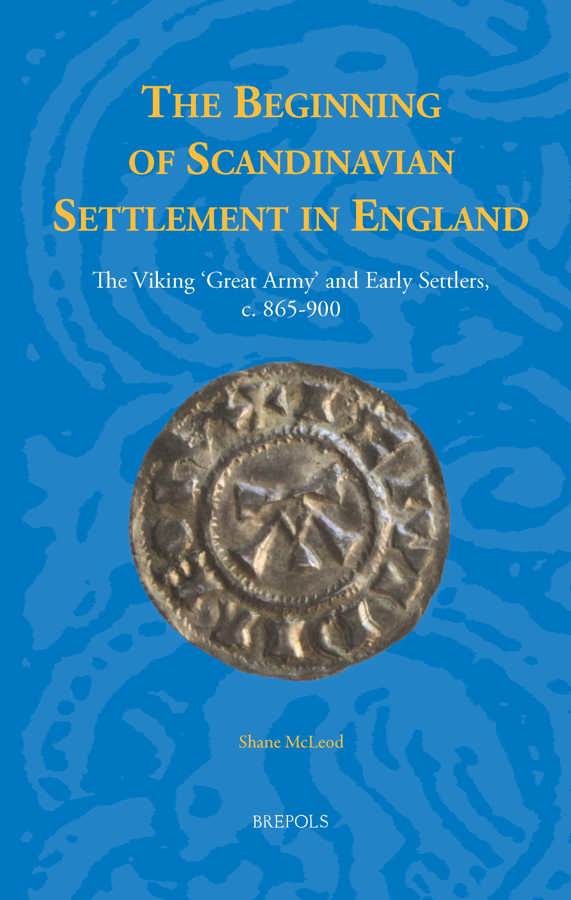
The Beginning of Scandinavian Settlement in England
The Viking 'Great Army' and Early Settlers, c. 865-900
Shane McLeod
- Pages: xvi + 330 p.
- Size:156 x 234 mm
- Illustrations:8 b/w, 3 tables b/w.
- Language(s):English, Old English
- Publication Year:2014
- € 95,00 EXCL. VAT RETAIL PRICE
- ISBN: 978-2-503-54556-1
- Hardback
- Available
- € 95,00 EXCL. VAT RETAIL PRICE
- ISBN: 978-2-503-55902-5
- E-book
- Available
How the origins of the first Scandinavian settlers in England affected the acculturation process.
"McLeod’s first monograph is a thorough and rewarding appraisal of the conditions relating to the early phase of Scandinavian settlement in England, and a worthy addition to the shelves of a scholar engaged in this period." (Roderick McDonald, in: Parergon 31.2, 2014, p. 192-194)
"(...) Ce livre représente donc une contribution importante et intelligente au débat sur le phénomène viking. Son argumentation est claire, pédagogique même, ponctuée d’états des lieux et de conclusions provisoires. Sa vision des choses est neuve et stimulante (...)." (Alban Gautier, dans: Le Moyen Âge, CXXI, 2015, p. 263-265)
"(...) McLeod therefore does all parties a great service by assembling and reviewing a good deal of the pieces that make up the puzzle. He boldly imagines some new pieces to make a full picture emerge. Many readers will value McLeod's book for its up-to-date review, while the model suggested may encourage further research. (...) the book serves as a highly useful field guide." (P. Holm, in: The Medieval Review, 15.08.70)
"What can be said with confidence is that no serious future historian dealing with the micel here and its aftermath will be able to ignore the case that McLeod has argued in his book." (John Kennedy, in: Journal of the Australian Early Medieval Association 11, 2015, p. 110-112)
“This book is a very useful re-evaluation of the issues surrounding Scandinavian settlement in England in the ninth century (…) In this book, McLeod does a truly commendable job of pulling a vast and diverse array of evidence from different disciplines into the service of his thesis. Some of his questions and propositions could, and indeed should, prompt a re-evaluation of our understanding, not just of Scandinavian settlement in the ninth century, but also of later waves of settlement.” (Pragya Vohra, in Saga-Book, XLI, 2017, p. 152-153)
The conquest and settlement of lands in eastern England by Scandinavians represents an extreme migratory episode. The cultural interaction involved one group forcing themselves upon another from a position of military and political power. Despite this seemingly dominant position, by 900 CE the immigrants appear to have largely adopted the culture of the Anglo-Saxons whom they had recently defeated. Informed by migration theory, this work proposes that a major factor in this assimilation was the emigration point of the Scandinavians and the cultural experiences which they brought with them.
Although some of the Scandinavians may have emigrated directly from Scandinavia, most of the first generation of settlers apparently commenced their journey in either Ireland or northern Francia. Consequently, it is the culture of Scandinavians in these regions that needs to be assessed in searching for the cultural impact of Scandinavians upon eastern England. This may help to explain how the immigrants adapted to aspects of Anglo-Saxon culture, such as the issuing of coinage and at least public displays of Christianity, relatively quickly. The geographic origins of the Scandinavians also explain some of the innovations introduced by the migrants, including the use of client kings and the creation of ‘buffer’ states.
Introduction
Chapter 1. Sources and Problems
Chapter 2. Migration Theory and the Scandinavian Migration to Eastern England
Chapter 3. The Likely Origins of the Early Scandinavian Settlers
Chapter 4. The Role of Client Kings
Chapter 5. Political and Economic Innovation and Acculturation:
Chapter 6. Christianization and the Strange Case of Scandinavian Adaptability
Conclusion
Bibliography
Index




